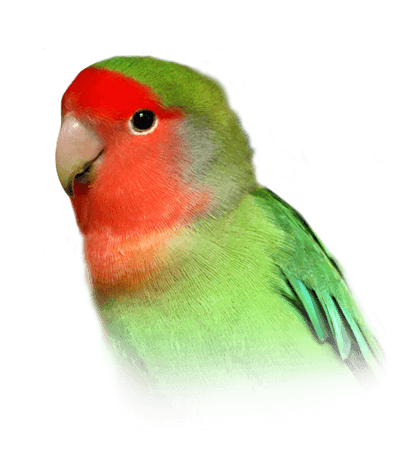
Scientific Name: Agapornis roseicollis
Description:
- Appearance: Peach-faced Lovebirds are small, charming birds known for their bright green bodies and distinctive peach-colored faces. They have a stocky build and a short, blunt tail. Color mutations can vary, resulting in a range of beautiful plumage colors.
- Size: They typically measure about 6 inches (15 cm) in length.
- Sexual Dimorphism: Males and females look very similar and are difficult to distinguish by appearance alone.
Lifespan:
- Peach-faced Lovebirds generally live for about 10 to 15 years in captivity, though they can live longer with excellent care.
Habitat:
- Natural Habitat: They originate from arid regions in southwestern Africa.
- In Captivity: They require a cage that allows them to fly and exercise, with plenty of space for toys, perches, and nesting materials. Regular out-of-cage time in a safe, bird-proofed area is also essential for their well-being.
Behavior:
- Social Interaction: True to their name, Peach-faced Lovebirds are known for their affectionate and social nature. They can form strong bonds with their owners or with a bird companion.
- Vocalization: While not known for mimicking speech, they are quite vocal, making chirps and tweeting sounds. They can be noisy, especially when seeking attention.
- Activity Level: They are active and playful birds, requiring a variety of toys for mental stimulation and to satisfy their natural chewing instinct.
Diet:
- In the Wild: Their diet mainly consists of seeds, fruits, and vegetables.
- In Captivity: A balanced diet includes high-quality pellets, fresh fruits, vegetables, and a limited amount of seeds. Fresh water should always be available.
Health Care:
- Veterinary Check-ups: Regular visits to an avian vet are important for health monitoring. They can be prone to conditions like respiratory infections and vitamin A deficiency.
- Signs of Illness: Changes in behavior, appetite, feather condition, and droppings can indicate health issues.
Breeding:
- Breeding in Captivity: If provided with the right environment, including a nesting box and proper nutrition, they can breed readily in captivity.
- Clutch Size: The female typically lays 4 to 6 eggs per clutch.
Conservation Status:
- Peach-faced Lovebirds are not currently endangered, but responsible pet ownership and breeding are important to maintain healthy captive populations.
Tips for Potential Owners:
- Companionship: Consider keeping them in pairs to prevent loneliness, but note that paired birds may bond more with each other than with humans.
- Time Commitment: Daily interaction and socialization are necessary, especially for single birds.
- Noise and Activity: Be prepared for their vocalizations and ensure you can provide enough mental and physical stimulation.
Conclusion: Peach-faced Lovebirds are delightful and affectionate pets, ideal for those who appreciate their lively and social nature. They require dedicated care, including a proper diet, regular socialization, and a stimulating environment. Their small size and playful demeanor make them popular among bird enthusiasts, but like all pets, they thrive best with attentive and committed caregivers.
FAQ’s
Here are 10 frequently asked questions about Peach-Faced Lovebirds, complete with answers:
What is the typical lifespan of a Peach-Faced Lovebird?
- Peach-Faced Lovebirds generally live for about 10 to 15 years in captivity, although with optimal care, some can live even longer.
Can Peach-Faced Lovebirds talk or mimic sounds?
- While they are not known for their ability to mimic human speech, they are quite vocal and can produce a variety of chirps and tweets.
What kind of diet is best for Peach-Faced Lovebirds?
- A balanced diet for Peach-Faced Lovebirds should include high-quality pellets, fresh fruits and vegetables, and a limited amount of seeds. Fresh water should always be accessible.
How much space does a Peach-Faced Lovebird need?
- They require a cage that allows them enough room to fly and exercise. The cage should be equipped with toys, perches, and nesting materials to keep them mentally stimulated.
Are Peach-Faced Lovebirds good for beginners?
- Yes, their small size and relatively easy care make them suitable for beginners. However, potential owners should be aware of their need for social interaction and mental stimulation.
How can I tell if my Peach-Faced Lovebird is healthy?
- Signs of good health include bright, clear eyes, clean and well-preened feathers, active behavior, a good appetite, and normal droppings.
Do Peach-Faced Lovebirds need a lot of social interaction?
- Yes, they are highly social birds and thrive on regular interaction. If kept alone, they require significant attention from their human caregivers. Keeping them in pairs can help meet their social needs.
What are common health issues in Peach-Faced Lovebirds?
- Common health issues include respiratory infections, vitamin A deficiency, and in some cases, feather plucking due to stress or boredom.
How do I ensure my Peach-Faced Lovebird is not bored?
- Provide a variety of toys, rotate them regularly, and spend interactive time daily. Engaging them in play and foraging activities can also help keep them mentally stimulated.
Can Peach-Faced Lovebirds be kept with other bird species?
- While they can sometimes coexist with other small bird species, careful introduction and monitoring are necessary. Each bird’s temperament and compatibility should be assessed to ensure safe cohabitation.
These FAQs provide a general overview of caring for Peach-Faced Lovebirds, helping potential and current owners understand the basics of their care, behavior, and needs.
